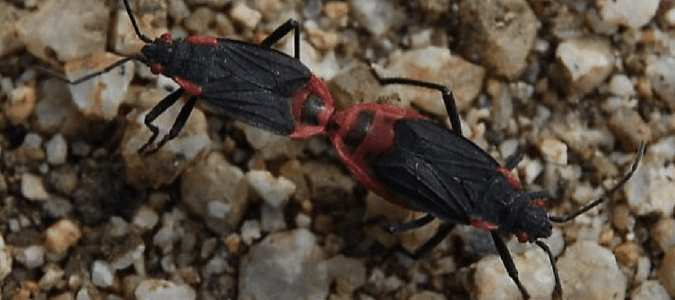
“Unknown insect – Jadera haematoloma” by Eugene Zelenko is licensed under CC BY-SA 3.0
If you’re like most people, the term or phrase “Jadera haematoloma” means nothing. There’s even a chance you’ve never even heard it before. As with most insects, the bug connected with this term is often known by its common name, not scientific. Instead, most people refer to this bug as either the red-shouldered bug, the goldenrain tree bug, or simply the Jadera bug. Do any of these names ring a bell?
Jadera haematoloma: What You Need to Know About This Bug
Found across the United States, the Jadera bug is easily identifiable and quite common. But because of this name confusion, we thought it would be an excellent time to dive deeper into the facts about this species to understand a bit more. Let’s explore together.
First, What Do They Look Like?
As you can see in the photo above, one of the more apparent characteristics of the Jadera bug is its bold colors. Its body is dark black with distinctive lateral red markings along its head and pronotum; its legs and antennae are also black. Its fierce red eyes also set it apart from other insects of similar color. Nymphs, conversely, are primarily red with a black pronotum and wings.
Another distinguishing characteristic is its small size. The Jadera Bug ranges from 10 to 14 millimeters long and is about three to four millimeters wide. Sometimes confused with boxelder bugs, other short-winged bugs of the same family as Jadera bugs can be more minor, typically seven to eight millimeters long.
Where Can Jadera Bugs Be Found, and What Do They Eat?
Due to the warm climate, Jadera Bugs can be found year-round in states like California, Texas, Hawaii, and Florida. Similarly, they can also be found in the Caribbean, Mexico, Central America, Columbia, and Venezuela.
In locations where winter months are colder, both adults and nymphs hibernate. This species typically emerges in large numbers in these more unconscious states in April and May. The Jadera Bug is usually found in large concentrations regardless of the time of year.
These distinctive insects are found chiefly in yards, gardens, and other areas with lush vegetation. Unlike other insects, though, they don’t cause any harm to your plants or vegetables. Instead, Jadera bugs feed on leaking tree sap, dead insects, or fallen seeds from nearby trees. They feed on the sap from foliage, flowers, and buds and benefit your backyard garden.
The Jadera bug’s favorite food, though, is the seed of the goldenrain tree, which is why it is sometimes referred to as the goldenrain tree bug.
How Do I Get Rid of Them?
As mentioned above, this bug causes no harm to your lawn, backyard garden, or family. And in most cases, removal or control isn’t necessary. Still, some owners prefer them gone since they can be a nuisance.
Like other insects and bugs, removing the Jadera bug’s food source is a surefire way to reduce the number of bugs on your property. For Jadera bugs, try raking your grass to remove the fallen seeds the bugs are feeding on. The best time to do this is during the fall months. If you find Jadera bugs inside your home—which may happen on rare occasions—vacuum them up to remove them.
One of the best ways to prevent the Jadera bug from making its home in your backyard is to remove the trees or plants that are attracting it simply.
ABC Is The Expert on Pests
The warm, humid climate in the southern states offers the perfect habitat for Jadera bugs and many other lawn-dwelling insects. If you are having trouble identifying a bug in your yard or wonder which bugs are pests and which are harmless, the experts at ABC Home & Commercial can help. Our highly-trained and knowledgeable technicians can thoroughly assess your outdoor areas to determine what’s destroying your grass or which insects might be munching on your plants. After understanding your problem better, we can propose a treatment plan to protect your lawn while safeguarding your pets and your family so your yard can stay healthy and green.